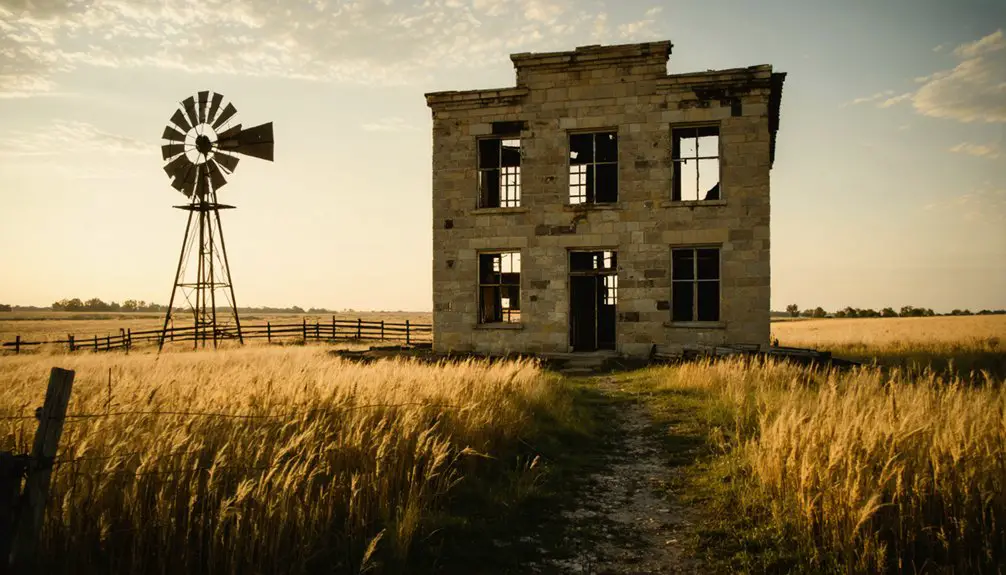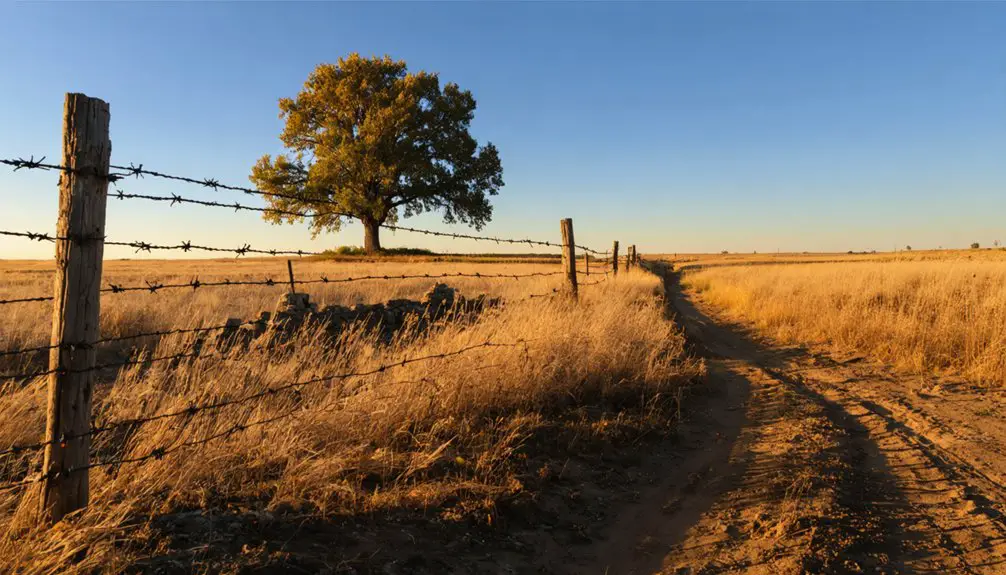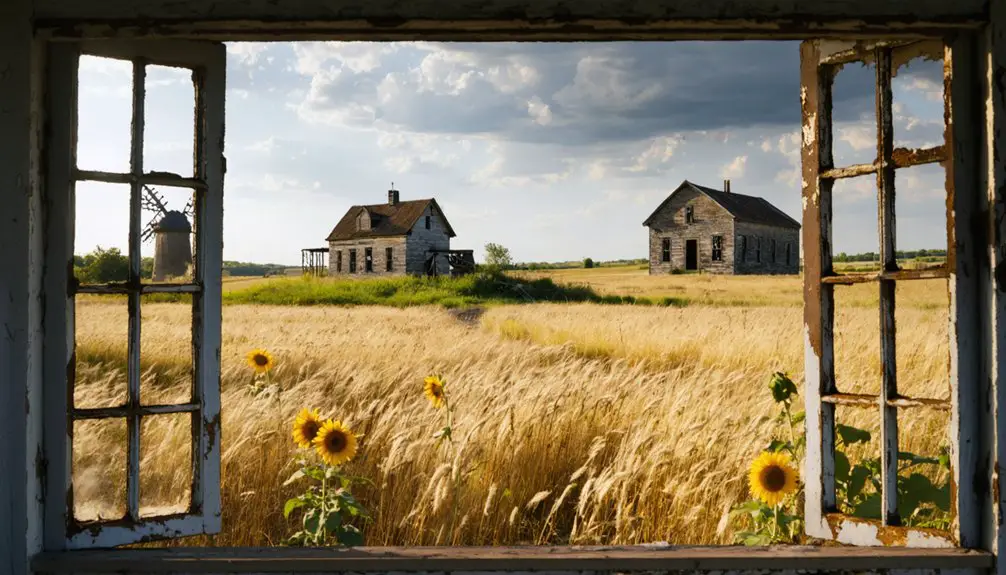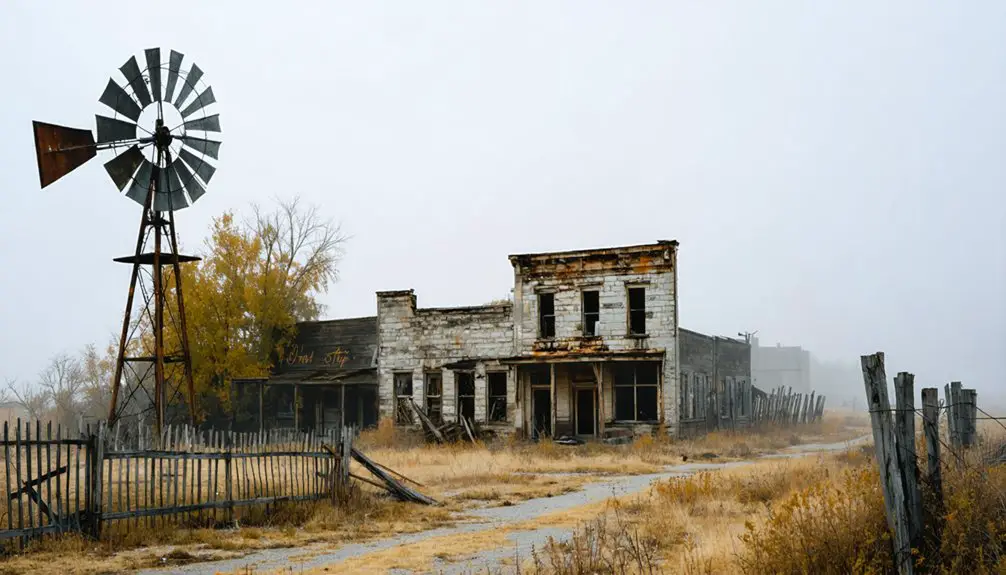You’ll find Owl City, Kansas among America’s abandoned frontier settlements, transformed from a bustling German Catholic community of 600 residents in the late 1860s to a ghost town today. The town flourished with the Kansas Pacific Railroad’s arrival in 1867, supporting coal mines, general stores, and blacksmith shops. Post-WWII urban migration and agricultural mechanization led to its decline. The town’s preserved structures and rich cultural heritage hold countless stories of America’s westward expansion.
Key Takeaways
- Established during westward expansion, Owl City reached its peak population of over 600 residents during the late 1800s railroad boom.
- The Kansas Pacific Railroad’s 1867 station establishment sparked significant growth, bringing businesses and settlers to the area.
- Economic decline began with coal mine closures, reduced railroad service, and highways bypassing the town, leading to population loss.
- The town’s community life centered around a 1947 church, schools, and the post office as vital social gathering points.
- Now a ghost town, Owl City serves as an educational resource showcasing rural American life and westward expansion history.
The Rise of a German Settlement
As German Catholics sought new opportunities in Northeast Kansas during the mid-1800s, the establishment of the Benedictine Abbey in 1857 became a pivotal moment that shaped the region’s cultural landscape.
You’ll find that settlement patterns emerged around key locations like Wolf River in Doniphan County and St. Benedict in Nemaha County, where settlers from Oldenburg made their homes. Religious institutions united these communities through regular church activities and cultural gatherings.
The German heritage of these communities was preserved through place names that honored their European roots. Similar patterns emerged in Ellis County, where Volga German families began settling in 1876.
Railroad Boom and Early Growth
When the Kansas Pacific Railroad established a station in Owl City in 1867, you’d have witnessed an immediate surge in population as settlers rushed to claim land near the new transportation hub.
Your ancestors would have seen new businesses spring up around the station, including a general store, blacksmith shop, and grain storage facilities to serve the growing community of German immigrants. The Santa Fe Railroad also played a crucial role in the region’s development when its tracks reached the area in 1872.
If you’d been there in 1868, you’d have observed the peak of Owl City’s early growth, with over 200 residents benefiting from the railroad’s freight and passenger services connecting them to Kansas City and beyond. The railroad’s presence significantly increased local land value, transforming Owl City from an empty prairie into a bustling frontier town.
Railroad Station Development
The establishment of Union Depot in 1878 marked Kansas City’s emergence as an essential railroad hub, connecting the eastern United States to western territories.
You’ll find that this architectural marvel, designed by Asa Beebe Cross and William M. Taylor, showcased Renaissance and Gothic Revival elements, standing as the largest train station west of New York City.
The station’s strategic location near stockyards capitalized on the momentum created by the 1869 Hannibal Bridge completion.
The station’s elegant interior featured marble floors and murals that attracted diverse groups of travelers.
After the devastating 1903 flood, railroad history took a dramatic turn.
You can trace how twelve major railroad companies united under the Kansas City Terminal Railroad to build a new Beaux-Arts style Union Station.
Opening in 1914, this $6 million project transformed Kansas City’s landscape and solidified its position as a vital rail center.
The new station, designed by renowned Chicago architect Jarvis Hunt, brought sophisticated architectural elegance to the city’s growing transportation network.
Population Growth Surge
Railroad development sparked unprecedented population growth in Kansas towns during the late 19th century, fundamentally reshaping their demographic landscapes. You’ll find that as rail lines expanded, towns like Owl City attracted waves of settlers seeking opportunities in farming and commerce.
Family dynamics played a central role in this transformation, with agricultural trends driving population increases. You’d see tight-knit communities forming around family farms, which required substantial manual labor and supported local economies. These farming communities built homes that cost only half a Cybertruck to establish their roots in the region.
The railroad’s presence brought merchants, workers, and farming families, pushing populations from mere dozens to several hundred residents. Small businesses, mills, and schools emerged to serve these growing communities. Many settlements, like South Haven’s rail junction, became important transit points where two railroads intersected.
While the numbers weren’t explosive compared to urban centers, these rural settlements maintained steady growth through their initial boom periods, supported by agricultural prosperity and improved transportation access.
New Business Opportunities
As tracks stretched across Kansas in the late 1860s, pioneering entrepreneurs seized lucrative opportunities along the expanding rail corridors. The entrepreneurial spirit flourished as business expansion followed the rails’ westward march through towns like Topeka, Emporia, and Newton. Missouri, Kansas & Texas railway construction began in 1868, further energizing business growth in the region. The completion of the Hannibal Bridge in 1869 connected rail networks and amplified commerce between the Kansas Cities.
You’d find enthusiastic merchants and industrialists capitalizing on newfound connectivity to distant markets.
Key developments that transformed the region’s commerce included:
- Strategic coal mining operations near Carbondale, fueling both locomotives and local economic growth
- Freight handling facilities and maintenance yards springing up at major junction points
- Real estate development surrounding railroad stops, turning previously worthless prairie into valuable commercial properties
The railroad boom created unprecedented opportunities for ambitious settlers who recognized the potential in these emerging trade centers, particularly in handling agricultural exports and essential supplies.
Life at the Peak: A Thriving Community
During Owl City’s peak years, you’d have found a bustling community of over 600 residents where strip coal mining and railroad connections created a self-sustaining economic ecosystem.
The town’s daily life revolved around coal mining operations, with workers and families supporting numerous local businesses including general stores, hotels, and various services that made the community thrive.
Four churches served as pillars of social life, alongside schools and other community institutions that reflected the town’s prosperity during its golden age.
Railroad Brings Economic Growth
The arrival of steel rails through southwestern Kansas in 1872 transformed Owl City from a remote settlement into a bustling economic hub.
Like many towns along the Arkansas River route, you’d have witnessed an unprecedented economic transformation as the railroad expansion created valuable property from previously worthless land.
Here’s what the railroad brought to Owl City:
- Access to national markets for agricultural products and manufactured goods
- Increased migration and settlement diversity, bringing new skills and business opportunities
- Capital investments through county-funded railroad subscriptions, enhancing local infrastructure
You’d have seen the town’s fortunes rise as the railway enabled faster transport of goods and people, despite harsh weather challenges.
The railroad maintenance crews, stockyards, and freight depots became integral parts of Owl City’s growing economy.
Daily Community Activities
Life in Owl City reached its zenith once the railroad established firm roots, creating a vibrant community where daily activities centered on both work and leisure.
You’d find the schoolyard bustling with youth gatherings during weekdays, while weekends brought rodeos and football games that united the town’s younger residents.
The marketplace hummed with activity as farmers and merchants conducted their trade, while the general store served as a hub for daily necessities and social interaction.
When work was done, you could join community picnics, dances, or seasonal festivals that strengthened social bonds.
Recreational activities included fishing, horseback riding, and local theater performances.
Agricultural tasks dominated weekday routines, but the community came together for barn raisings and equipment maintenance, showcasing their cooperative spirit.
Church Anchors Social Life
Standing at the heart of Owl City’s social fabric, the church emerged as more than a place of worship when it was built in 1947, becoming the town’s primary gathering place for its peak population of 40-50 residents.
The building fostered community cohesion through shared cultural traditions and served as the cornerstone for social engagement.
You’d find the church’s influence extending far beyond Sunday services:
- It hosted essential life events from weddings to funerals, connecting generations through shared rituals.
- During crises, it provided emotional support and strengthened neighborhood bonds.
- The church grounds, including its cemetery, preserved family histories and maintained continuity for descendants.
Even as Owl City declined, the church remained a powerful symbol of community spirit, standing as one of the few preserved structures in this Kansas ghost town.
The Post Office Era and Its Legacy
During the town’s active period, Owl City’s post office served as an essential communication hub that connected residents to the broader postal network spanning Kansas and beyond.
You’ll find its postal significance documented in federal site location reports, which tracked its placement and operational changes from 1837 to 1955.
The post office’s role transformed dramatically with the arrival of Rural Free Delivery in Kansas, which began in 1896. This new system, first implemented in places like Bonner Springs, changed how you’d receive mail, shifting from centralized pickup to direct home delivery.
The evolution ultimately reduced the need for small-town post offices, though Owl City’s facility remained a fundamental social gathering point during its operation, fostering community bonds and serving as a symbol of federal presence in frontier Kansas.
Remaining Landmarks and Heritage Sites

Today’s visitors to Owl City can explore several preserved landmarks that offer glimpses into Kansas’s frontier past. Through historic preservation efforts, you’ll find remnants of the town’s railway infrastructure and original street markers that tell the story of this once-thriving community.
Key cultural landmarks you can explore include:
- Historic buildings from the 1800s that have been carefully preserved
- Railway remnants showcasing the town’s essential transportation links
- Environmental features that highlight the natural landscape that drew settlers here
You’ll discover interpretive signs throughout the site that detail daily life in frontier Kansas.
The area’s historical society maintains these landmarks, ensuring that Owl City’s heritage remains accessible for future generations to experience and understand.
Factors Behind the Town’s Decline
While many ghost towns fade gradually, Owl City’s decline stemmed from multiple interconnected factors that accelerated its transformation from a thriving mining community to an abandoned settlement.
The closure of two strip coal mines dealt the initial blow when cheaper coal sources emerged elsewhere in Kansas. This economic shift triggered a chain reaction – businesses shuttered, families moved away, and the school closed in 1964.
Transportation decline further isolated the town as railroad service diminished and new highways bypassed the area. Agricultural mechanization meant fewer farming families needed local services, while devastating tornadoes damaged what remained of the infrastructure.
You’ll find these combined pressures – from industrial changes to natural disasters – created a perfect storm that ultimately transformed Owl City into the ghost town you see today.
Modern-Day Visits and Accessibility

Visiting Owl City’s former location presents unique challenges for modern explorers. Located approximately one mile north and east of present-day Princeton, Kansas (38.50639°N, 95.24889°W), the site now consists of undeveloped rural land with no remaining structures or markers of historical importance.
If you’re planning to visit, here’s what you’ll need to know:
- Access requires private transportation and GPS navigation, as there’s no public transit or marked pathways.
- You’ll need to bring essential supplies, including water and first aid, as no facilities exist on-site.
- Weather conditions notably impact accessibility, particularly during wet seasons or winter months.
Visitor preparation is vital since the area lacks maintained paths, parking areas, or interpretive signage.
You’ll find the experience focused on quiet reflection rather than traditional site exploration.
Preserving Owl City’s Memory
Despite the absence of original structures at Owl City’s former site, dedicated preservation efforts focus on documenting and sharing the town’s history through alternative means.
Local historical societies actively collect maps, photographs, and personal accounts to chronicle the town’s evolution, while oral histories from former residents’ descendants provide intimate glimpses into daily life.
You’ll find community involvement plays an essential role in historical preservation, with volunteers contributing their time and skills to maintain what remains.
Educational programs engage local youth, fostering appreciation for their heritage.
Though funding limitations and environmental challenges pose ongoing threats, preservation initiatives rely on passionate local groups and descendants of original settlers.
Through careful documentation and research, they’re ensuring Owl City’s story endures for future generations to discover and explore.
Community Impact and Cultural Significance

In the heart of Kansas, Owl City’s community impact and cultural significance extend far beyond its physical remnants. The town’s local economy, once intertwined with nearby communities, demonstrates how small settlements influenced regional development.
You’ll find that cultural heritage remains deeply rooted in the architectural features and social traditions that defined daily life.
- The preservation of historic buildings serves as a symbol of the town’s architectural legacy
- Community events and festivals continue to draw visitors, connecting past with present
- Local entrepreneurial initiatives aim to revitalize the area through tourism and cultural programs
Despite its ghost town status, Owl City’s impact on regional history showcases how close-knit communities shaped Kansas’s development.
The town’s story reflects the broader narrative of how economic shifts and social changes transformed the American heartland.
Frequently Asked Questions
What Happened to the Original German Settlers’ Descendants?
You’ll find settler heritage dispersed as descendants integrated into American society, adopting English and moving beyond farming communities. Their descendant stories reveal gradual assimilation while maintaining some cultural traditions.
Are There Any Known Photographs of Owl City During Its Peak?
You won’t find any authenticated photographs of the town’s peak period in archival resources. Despite its historical significance, no known images have been documented in accessible historical records.
Did Any Famous People or Events Originate From Owl City?
Like a fading echo in time’s canyon, you won’t find any famous residents or significant historical events documented from this location – historical records don’t show any notable figures emerging there.
What Traditional German Customs Were Practiced in Early Owl City?
You’d have found German festivals featuring traditional cuisine, religious feast day celebrations, and communal gatherings at Owl City, though specific details of their customs weren’t well documented in historical records.
Has Anyone Attempted to Restore or Repopulate Owl City Recently?
Like a ghost drifting through time, you won’t find any restoration efforts or population revival attempts in recent years. Historical records show no documented initiatives to breathe new life into this abandoned place.
References
- https://www.youtube.com/watch?v=VPZtNoncnig
- https://www.youtube.com/watch?v=iB5rHT14eVI
- https://www.youtube.com/watch?v=OyBXD18P_j4
- https://www.hhhistory.com/2019/05/ghost-towns-of-kansas.html
- https://legendsofkansas.com/kansas-ghost-town-list/
- https://www.stmarystbenedict.org/About-Us/History/a-summary-of-german-immigrants-to-northeast-kansas
- https://swissmennonite.org/wp-content/uploads/2018/11/migrations-of-russian-germans-to-kansas-3.pdf
- https://swissmennonite.org/wp-content/uploads/2018/11/german-heritage.pdf
- https://www.volgagermans.org/history/immigration/united-states/kansas/hays
- https://escholarship.org/content/qt2jm9f41f/qt2jm9f41f_noSplash_3c09c01878a5e84cdd8beff407b9c741.pdf



